In a statement made by Nikola Tesla on January 12, 1897 (during the Opening Ceremony of his invention of the hydro-electric power station) he said:
“We have many a monument of past ages; we have the palaces and pyramids, the temples of the Greek and the cathedrals of Christendom. In them is exemplified the power of men, the greatness of nations, the love of art and religious devotion. But the monument at Niagara has something of its own, more in accord with our present thoughts and tendencies. It is a monument worthy of our scientific age, a true monument of enlightenment and of peace. It signifies the subjugation of natural forces to the service of man, the discontinuance of barbarous methods, the relieving of millions from want and suffering“
In that same 1897 address Tesla also said:
“We have to evolve means for obtaining energy from stores which are forever inexhaustible, to perfect methods which do not imply consumption and waste of any material whatever. I now feel sure that the realization of that idea is not far off. The possibilities of the development I refer to, namely, that of the operation of engines on any point of the earth by the energy of the medium.”
We see in these statements from a time relatively early in Tesla’s life, he was 38 years old and in the most fruitful years of his career, that he is already hinting about a great discovery of his. A discovery about an aspect of nature which seemed to Tesla to hold the possibility of driving motive devices by connecting them directly to the “ambient medium” and to thereby place the “vast reservoir of negative charge” in the service of “relieving a wanting and suffering mankind”.
From the article “The Problem of Increasing Human Energy” which Tesla published in the June 1900 edition of Century magazine, (download here), in the section entitled “Energy from the Medium”, he states:
“…the upper air strata are permanently charged with electricity opposite to that of the earth. So, at least, I have interpreted my observations, from which it appears that the earth, with its adjacent insulating and outer conducting envelope, constitutes a highly charged electrical condenser containing, in all probability, a great amount of electrical energy which might be turned to the uses of man”
From the same article, the next section entitled “A departure from known methods” is very instructive. I have included this entire section below. Tesla writes:
A DEPARTURE FROM KNOWN METHODS – POSSIBILITY OF A “SELF-ACTING” ENGINE OR MACHINE, INANIMATE, YET CAPABLE, LIKE A LIVING BEING, OF DERIVING ENERGY FROM THE MEDIUM – THE IDEAL WAY OF OBTAINING MOTIVE POWER.
When I began the investigation of the subject under consideration, and when the preceding or similar ideas presented themselves to me for the first time, though I was then unacquainted with a number of the facts mentioned, a survey of the various ways of utilizing the energy of the medium convinced me, nevertheless, that to arrive at a thoroughly satisfactory practical solution a radical departure from the methods then known had to be made. The windmill, the solar engine, the engine driven by terrestrial heat, had their limitations in the amount of power obtainable. Some new way had to be discovered which would enable us to get more energy. There was enough heat-energy in the medium, but only a small part of it was available for the operation of an engine in the ways then known. Besides, the energy was obtainable only at a very slow rate. Clearly, then, the problem was to discover some new method which would make it possible both to utilize more of the heat-energy of the medium and also to draw it away from the same at a more rapid rate.
I was vainly endeavoring to form an idea of how this might be accomplished, when I read some statements from Carnot and Lord Kelvin (then Sir William Thomson) which meant virtually that it is impossible for an inanimate mechanism or selfacting machine to cool a portion of the medium below the temperature of the surrounding, and operate by the heat abstracted. These statements interested me intensely. Evidently a living being could do this very thing, and since the experiences of my early life which I have related had convinced me that a living being is only an automaton, or, otherwise stated, a “self-acting-engine”, I came to the conclusion that it was possible to construct a machine which would do the same. As the firststep toward this realization I conceived the following mechanism. Imagine a thermopile consisting of a number of bars of metal extending from the earth to the outer space beyond the atmosphere. The heat from below, conducted upward along these metal bars, would cool the earth or the sea or the air, according to the location of the lower parts of the bars, and the result, as is well known, would be an electric current circulating in these bars. The two terminals of the thermopile could now be joined through an electric motor, and, theoretically, this motor would run on and on, until the media below would be cooled down to the temperature of the outer space. This would be an inanimate engine which, to all evidence, would be cooling a portion of the medium below the temperature of the surrounding, and operating by the heat abstracted.
But was it not possible to realize a similar condition without necessarily going to a height? Conceive, for the sake of illustration, [the cylinder pictured above] enclosure T, as illustrated in diagram B, such that energy could not be transferred across it except through a channel or path O, and that, by some means or other, in this enclosure a medium were maintained which would have little energy, and that on the outer side of the same there would be the ordinary ambient medium with much energy. Under these assumptions the energy would flow through the path O, as indicated by the arrow, and might then be converted on its passage into some other form of energy. The question was, Could such a condition be attained? Could we produce artificially such a “sink” for the energy of the ambient medium to flow in? Suppose that anextremely low temperature could be maintained by some process in a given space; the surrounding medium would then be compelled to give off heat, which could be converted into mechanical or other form of energy, and utilized. By realizing such a plan, we should be enabled to get at any point of the globe a continuous supply of energy, day and night. More than this, reasoning in the abstract, it would seem possible to cause a quick circulation of the medium, and thus draw the energy at a very rapid rate.
Here, then, was an idea which, if realizable, afforded a happy solution of the problem of getting energy from the medium. But was it realizable? I convinced myself that it was so in a number of ways, of which one is the following. As regardsheat, we are at a high level, which may be represented by the surface of a mountain lake considerably above the sea, the level of which may mark the absolute zero of temperature existing in the interstellar space. Heat, like water, flows from high to low level, and, consequently, just as we can let the water of the lake run down to the sea, so we are able to let heat from the earth’s surface travel up into the cold region above. Heat, like water, can perform work in flowing down, and if we had any doubt as to whether we could derive energy from the medium by means of a thermopile, as before described, it would be dispelled by this analogue.
But can we produce cold in a given portion of the space and cause the heat to flow in continually? To create such a “sink,” or “cold hole,” as we might say, in the medium, would be equivalent to producing in the lake a space either empty or filled with something much lighter than water. This we could do by placing in the lake a tank, and pumping all the water out of the latter. We know, then, that the water, if allowed to flow back into the tank, would, theoretically, be able to perform exactly the same amount of work which was used in pumping it out, but not a bit more. Consequently nothing could be gained in this double operation of first raising the water and then letting it fall down.This would mean that it is impossible to create such a sink in the medium. But let us reflect a moment. Heat, though following certain general laws of mechanics, like a fluid, is not such; it is energy which may be converted into other forms of energy as it passes from a high to a low level. To make our mechanical analogy complete and true,we must, therefore, assume that the water, in its passage into the tank, is converted into somethingelse, which may be taken out of it without using any, or by using very little, power. For example, if heat be represented in this analogue by the water of the lake, the oxygen and hydrogen composing the water may illustrate other forms of energy into which the heat is transformed in passing from hot to cold. If the process of heat transformation were absolutely perfect, no heat at all would arrive at the low level, since all of it would be converted into other forms of energy. Corresponding to this ideal case, all the water flowing into the tank would be decomposed into oxygen and hydrogen beforereaching the bottom, and the result would be that water would continually flow in, and yet the tank would remain entirely empty, the gases formed escaping. We would thus produce, by expending initially a certain amount of work to create a sinkfor the heat or, respectively, the water to flow in, a condition enabling us to get any amount of energy without further effort. This would be an ideal way of obtaining motive power. We do not know of any such absolutely perfect process of heat-conversion,
and consequently some heat will generally reach the low level, which means to say, in our mechanical analogue, that some water will arrive at the bottom of the tank, and a gradual and slow filling of the latter will take place, necessitating continuous pumping out. But evidently there will be less to pump out than flows in, or, in other words, less energy will be needed to maintain the initial condition than is developed by the fall, and this is to say that some energy will be gained from the medium. What is not converted in flowing down can just be raised up with its own energy, and what is converted is clear gain. Thus the virtue of the principle I have discovered resides wholly in the conversion of the energy on the downward flow.”
Much later in Tesla’s life, when he was 76 years old, he began to discuss radiant energy in the public forum once again.
In a statement made on July 10, 1932, Tesla said:
“I have harnessed the cosmic rays and caused them to operate a motive device. Cosmic ray investigation is a subject that is very close to me. I was the first to discover these rays and I naturally feel toward them as I would toward my own flesh and blood. I have advanced a theory of the cosmic rays and at every step of my investigations I have found it completely justified. The attractive features of the cosmic rays is their constancy. They shower down on us throughout the whole 24 hours, and if a plant is developed to use their power it will not require devices for storing energy as would be necessary with devices using wind, tide or sunlight. All of my investigations seem to point to the conclusion that they are small particles, each carrying so small a charge that we are justified in calling them neutrons. They move with great velocity, exceeding that of light. More than 25 years ago I began my efforts to harness the cosmic rays and I can now state that I have succeeded in operating a motive device by means of them. I will tell you in the most general way, the cosmic ray ionizes the air, setting free many charges ions and electrons. These charges are captured in a condenser which is made to discharge through the circuit of the motor. I have hopes of building my motor on a large scale, but circumstances have not been favorable to carrying out my plan.”
In a further statement made on November 1st, 1933 Tesla said:
“This new power for the driving of the world’s machinery will be derived from the energy which operates the universe, the cosmic energy, whose central source for the earth is the sun and which is everywhere present in unlimited quantities.”
From periodical “Philadelphia Public Ledger” on November 2, 1933:
Inventor announces discovery to displace fuel in driving machinery. Calls Sun main source. A principle by which power for driving machinery of the world may be developed from the cosmic energy which operates the universe, has been discovered by Nikola Tesla, noted physicist and inventor of scientific devices, he announced today. This principle, which taps a source of power described as “everywhere present in unlimited quantities” and which may be transmitted by wire or wireless from central plants to any part of the globe, will eliminate the need of coal, oil, gas or any other of the common fuels, he said. Dr. Tesla in a statement today at his hotel indicated the time was not far distant when the principle would be ready for practical commercial development. Asked whether the sudden introduction of his principle would upset the present economic system, Dr. Tesla replied, “It is badly upset already.” He added that now as never before was the time ripe for the development of new resources. While in its present form, the theory calls for the development of energy in central plants requiring vast machinery. Dr. Tesla said he might be able to work out a plan for its use by individuals. The central source of cosmic energy for the earth is the Sun, Dr. Tesla said, but “night will not interrupt the flow of new power supply.”
A diagram of Tesla’s basic radiant energy receiver configuration is seen below:

You may refer to Tesla’s patent USPTO# 685957 titled “Apparatus for the Utilization of Radiant Energy” from the link below:
https://www.google.com/patents/US685958
And also see patent USPTO# 685958 titled Method of Utilizing Radiant Energy:
https://www.google.com/patents/US685957
In these patents Tesla explains:
“The sun, as well as other sources of radiant energy throw off minute particles of matter positively electrified, which, impinging upon the upper plate, communicate continuously an electrical charge to the same. The opposite terminal of the condenser being connected to ground, which may be considered as a vast reservoir of negative electricity, a feeble current flows continuously into the condenser and inasmuch as the particles are …charged to a very high potential, this charging of the condenser may continue, as I have actually observed, almost indefinitely, even to the point of rupturing the dielectric.”
Given Tesla’s undeniable genius, and given that the state of technology in today’s modern civilization can be traced back either directly or indirectly to the inventive contributions of this one man, I have taken Tesla’s conceptions of radiant energy at their word and set to see if I could find any of his basic concepts on my bench.
Tesla thought of the sun as an enormous sphere of electricity with a potential charge of around 200 billion volts. The earth he thought of as a “vast reservoir of negative electricity”. The sun gives energy to the Earth. You will notice in this writing that I always use the electrical engineering notation:
Vss (Voltage Source, negative) as the source of charge
Vdd (Voltage Drain, positive) as the end point for a given charge path segment.
This is aligned with the true flow of charge and opposite of the backwards and confusing (but surprisingly prevalent) “conventional” notation for charge flow.
The astronomical degree of electrical force existing between the Earth and the sun is a major source of Tesla’s ever-available cosmic energy, however Tesla noted that other sources include all other forms of energy traversing the cosmos.
What follows is how I have pictured in my mind Tesla’s model for the solar/terrestrial capacitive system:
Step 1: In addition to the vast light we can perceive from the sun, Telsa suggests that there exists also unseen and undetectable highly charged radiations (Radiant Energy). This energy charges the Vss plate of the capacitor shown below. (Note: Vss = Voltage Source, aka. ” – “)
Step 2: In some sense, the energy can be said to flow from the sun to the Earth through a vast dielectric (the vacuum of space) and thus form a kind of capacitor as shown below.
Step 3: When Radiant Energy reaches the Earth’s outer atmosphere, it becomes the system’s charged Vdd plate. (Note: Vdd = Voltage Drain, aka. ” +”)
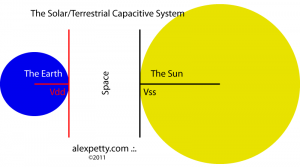
One charge path segment’s drain is the next segment’s source and so the Vdd plate above (Earth’s charged ionosphere) becomes the Vss plate in the next step (described below and corresponding to the image below).
Step 4: The radiant energy from the sun charges the Earth’s outer atmosphere.
Step 5: The earth now acts like a large spherical capacitor. The energy from the top plate (Vss) gives rise to a charge on the bottom plate (Vdd) through the capacitor’s dielectric which in this case in the planet’s atmosphere.
The charged Radiant Energy particles from the sun are received by the Earth’s ionosphere. Between the charged ionosphere (Vss) and the Earth’s surface (Vdd, a distance of 60 miles), it can be shown that there is a potential electrical gradient of around 360,000 volts. The gases of the Earth’s atmosphere act as an insulator between these two charged “plates”. In this way, Tesla viewed the Earth as a massive spherical capacitor.
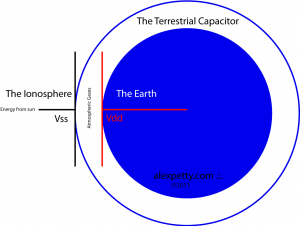
The Vdd plate shown left (the Earth’s surface) becomes the Vss plate for our next step since the energy we are considering is cascading through charge path segments. The next step is described below and corresponds to the next two images.
Step 6: The energy from the charged ionosphere (charged by the sun) now charges the Earth’s surface.
Here is the most convenient opportunity we have to possibly detect some physical expression of these dynamics at work. Here we may be able to develop some evidence that one can tap the electrical energy flowing to the Earth from the sun.
Towards testing this, here are the steps I took:
Step 7: Tap the Earth’s “vast reservoir of negative electricity” by constructing a Vdd plate to receive electrical energy from the Earth’s surface, the Vss plate. I imagined this plate to act as the “radiant receiver plate” shown as component P on Tesla’s drawing below.
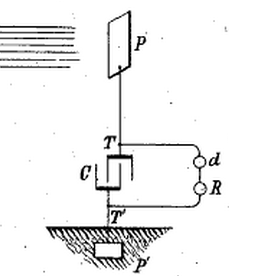
My arrangement (shown below) is the same as Tesla’s (pictured above), however, with the exception that rather then using an aerial ”antenna-like” receiver, the plate in my drawing is designed to receive charge capacitively from the surface of Earth, the “vast reservoir” of charge. I am not discounting the “antenna” approach as their exists much evidence of its merit in the work of Dr. Thomas Henry Moray. I am just sharing with you my experimental approach.
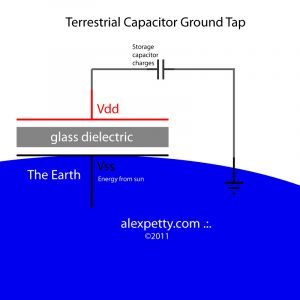
7a) Place a sheet of glass (or anything with a high dielectric value) on the surface of the Earth
7b) Place a sheet of metal on top of your dielectric to form a top plate for your “ground tap”. I find that aluminum sheet metal which you have polished to a high shine yields the best results I’ve seen so far.
Step 8: Make a storage capacitor by attaching one end of a capacitor to your Vdd plate. Tesla said that this capacitor should be of “considerable electrostatic capacity” and should be very well insulated in view of the fact that the electrical energy is supplied at a very slow rate to the condenser”.
Step 9: Attach the other end of your storage capacitor to a ground rod that is driven solidly into the surface of the Earth.
Step 10: Measure the voltage across the terminals of your storage capacitor. You will see that the capacitor charges to about 1.25 volt DC within several minutes. This result will vary depending upon the quality of your storage capacitor. I have seen that lesser capacitors in my inventory can only be charged to 0.5 volts. Tesla offers guidance about the construction of this capacitor noting “I use by preference the best quality of mica as dielectric, taking every possible precaution in insulating the armatures, so that the instrument may withstand great electrical pressures without leaking and may leave no perceptible electrification when discharging instantaneously”. It may be the case that Tesla’s capacitors were built so extraordinarily well that his capacitor’s charged “indefinitely” without any leakage occurring. Tesla states that he observed his storage capacitors to charge to such high pressures that his capacitor actually ”ruptured” or exploded. This implies that he had achieved close to zero leakage in his constructions and that his storage capacitors charged slowly up to very high voltages.
For my case, while 1.25 VDC is not very much charge pressure, it does serve as compelling evidence along these lines of inquiry. Encouraged, I wondered, how I might be able to open the flood gates of energy that Tesla claimed is available right under our feet?
Electrostatic Charge of the Earth
It can be calculated that the earth has a static electric charge of 96,500 coulombs. Capacitance is equal to the charge in Coulombs (C) divided by the charge pressure gradient (voltage, V). The charge pressure gradient that exists between the Earth’s ionosphere (Vss) and the planet’s surface (Vdd) can be shown to be 360,000 volts. Plugging in these parameters to the formula we see that the Earth is a massive spherical capacitor with a capacitance of 0.25 farads.
If one applies the formula for calculating the energy stored in a capacitor (E =1/2CV^2) to the Earth, it can be shown to possess 1.6 x 10^11 joules. This is equivalent to 4.5 megawatt-hours of electrical energy available for use at every point! In order to tap this energy, Tesla tells us in the 1900 article (included above) that we must accomplish two things:
- We must “make an energy sink” or “cold hole”
- We must “devise a way of making this sink oscillate”
This “sink” must be at a lower energy state than the surrounding medium and in order for energy to continually flow into it, energy must also be continually pumped out of it. In other words, the oscillations delivered to the load must be tuned to the oscillations driving the “sinks” pumping action while still providing sufficient charge pressure and flow to meet the electrical needs of the load.
But how can we make an “energy sink”? How can we create Tesla’s “cold hole”? Tesla offers some food for thought on this question.
In the 1900 article mentioned above, Tesla says:
“consider a closed cylinder such that energy could not be transferred across it except through a channel or path O and that, by some means or other, in this enclosure a medium were maintained which would have little energy, and that on the outer side of the same there would be the ordinary ambient medium with much energy. Under these assumptions the energy would flow through the path O, as indicated by the arrow, and might then be converted on its passage into some other form of energy. Could we produce artificially such a “sink” for the energy of the ambient medium to flow in [and] … be enabled to get at any point of the globe a continuous supply of energy, day and night?”
Tesla’s energy sink
Tesla goes on to further describe how we might produce a cold region in a given portion of space and thereby cause heat to flow in continually.
“Creating such a “cold hole” in the medium would be like creating in a lake either an empty space or a space filled with something much lighter than water. This we could do by placing in the lake a tank, and pumping all the water out of the latter. We know, then, that the water if allowed to flow back into the tank, would, theoretically, be able to perform exactly the same amount of work which was used in pumping it out, but not a bit more.”
Tesla, then asks his reader to “reflect a moment” noting:
“Heat, though following certain general laws of mechanics, like a fluid, is not such; it is energy which may be converted into other forms of energy as it passes from a high to low level…assume that the water, in its passage into the tank, is converted into something else, which may be taken out of it without using any, or very little, power. For example, if heat [is represented] by the water of the lake, the oxygen and hydrogen composing the water may illustrate other forms of energy into which the heat is transformed in passing from hot to cold.”
The “sink” or “cold hole” that Tesla is suggesting is a coil that is set into oscillation at its resonant frequency by an external power source. If the coil can be made to exist electrically at a lower energy state the surrounding medium, then during this low energy cycle of the coil’s operation, it will appear to other parts of the system as the Vdd plate of a capacitor.
Turning on the Energy Fire Hose
According to Tesla there can be extracted from the surface of Earth, using a very well constructed capacitor that exhibits no charge leakage, an endless stream of charge. This is quite something! Tesla said, “I have actually observed, [an Earth connected capacitor] charge almost indefinitely, even to the point of rupturing the dielectric.”
In my own experience, using only the capacitor’s available to me mostly from scavenged electronic parts, that my best capacitor in terms of exhibiting low leakage during slow charging, is capable to receive passively from the Earth an electrostatic charge of 1.25V DC within a period of 2 minutes.
I have measured the capacitance between the Earth’s surface and my aluminum plate to be approximately 1.5nF. My results have also confirmed Tesla’s observations that that larger surface areas yield higher charging. While 1.25V DC is a very small amount of charge pressure and while not sufficient for developing a truly useful effect, it is certainly a good start! The question then becomes how can we excite local charge (within the Earth) to oscillations sufficiently high to produce useful power?
This is the very issue that Tesla spent a lot of time on. A good number of Tesla’s more interesting inventions involve the use of resonant circuits capable of inducing high frequency oscillations.
From my tests to date, I feel encouraged that using Tesla’s methods, it may be possible to arrange inductors in relation to a storage capacitor in such a way as to induce oscillations of local charge within the Earth. If the amplitudes of these oscillations can be made sufficiently high, they could yield useful results. So far, I have not been able to achieve this effect in the least, but I think it may be a matter of trial and error in building coils and electronics tuning.
From Tesla:
“Ere many generations pass, our machinery will be driven by a power obtainable at any point of the universe. This idea is not novel. Men have been led to it long ago by instinct or reason; it has been expressed in many ways, and in many places, in the history of old and new. We find it in the delightful myth of Antheus, who derives power
from the earth; we find it among the subtle speculations of one of your splendid mathematicians and in many hints and statements of thinkers of the present time. Throughout space there is energy. Is
this energy static or kinetic! If static our hopes are in vain; if kinetic — and this we know it is, for certain — then it is a mere question of time when men will succeed in attaching their machinery to the very wheelwork of nature.”
.:.
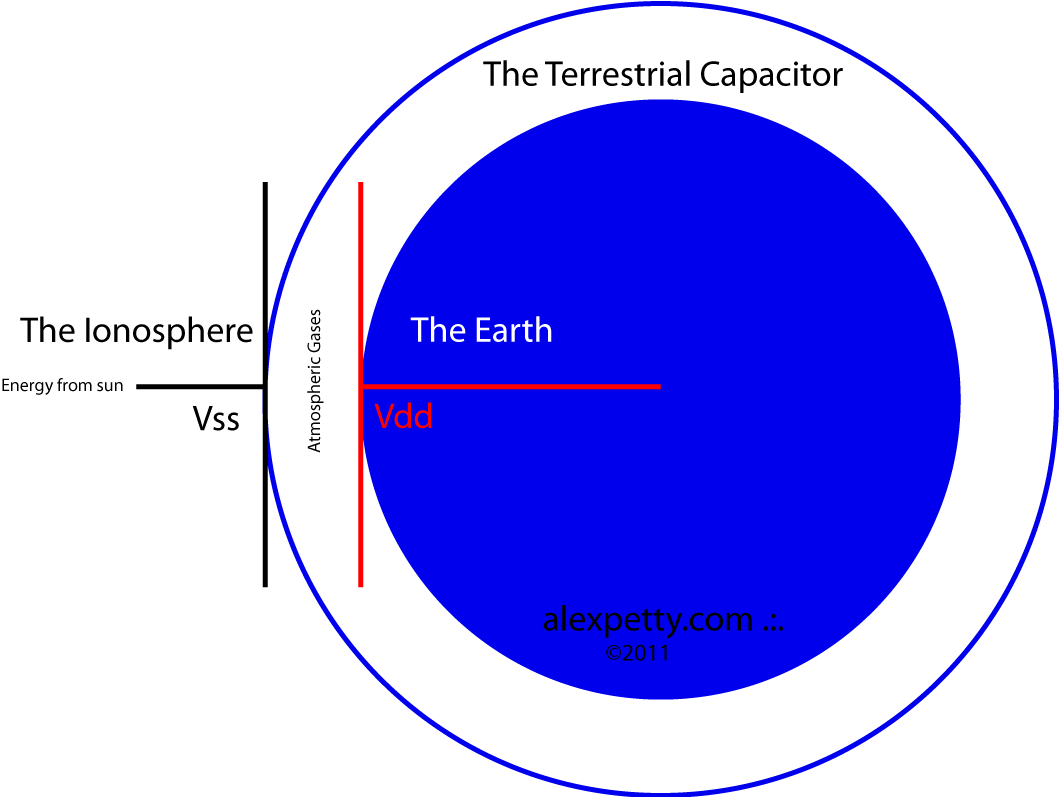
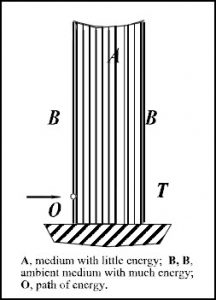
Simply wonderful.
Perhaps magnetism and flux could supply the oscillation needed if a coil was properly built in a helical form. If in an ideal world or vacuum, no energy would be lost and the system would self maintain perpetually. However, over time the magnet may need a nudge to reinstate propulsion.
I am very interested in this idea of wireless energy that is off the grid. From the pyramids 3500 years ago to Tesla’s ideas in 1900 – is there anywhere else inbetween these two dates – any examples of any sort of buildings being able to create such “free” energy? I wonder how this would change the way societies/governments function…”